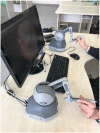Distinguishing Intermediate and Novice Surgeons by Eye Movements
- PMID: 33013592
- PMCID: PMC7511664
- DOI: 10.3389/fpsyg.2020.542752
Distinguishing Intermediate and Novice Surgeons by Eye Movements
Abstract
Surgical skill-level assessment is key to collecting the required feedback and adapting the educational programs accordingly. Currently, these assessments for the minimal invasive surgery programs are primarily based on subjective methods, and there is no consensus on skill level classifications. One of the most detailed of these classifications categorize skill levels as beginner, novice, intermediate, sub-expert, and expert. To properly integrate skill assessment into minimal invasive surgical education programs and provide skill-based training alternatives, it is necessary to classify the skill levels in as detailed a way as possible and identify the differences between all skill levels in an objective manner. Yet, despite the existence of very encouraging results in the literature, most of the studies have been conducted to better understand the differences between novice and expert surgical skill levels leaving out the other crucial skill levels between them. Additionally, there are very limited studies by considering the eye-movement behaviors of surgical residents. To this end, the present study attempted to distinguish novice- and intermediate-level surgical residents based on their eye movements. The eye-movement data was recorded from 23 volunteer surgical residents while they were performing four computer-based simulated surgical tasks under different hand conditions. The data was analyzed using logistic regression to estimate the skill levels of both groups. The best results of the estimation revealing a 91.3% recognition rate of predicting novice and intermediate surgical residents on one scenario were selected from four under the dominant hand condition. These results show that the eye-movements can be potentially used to identify surgeons with intermediate and novice skills. However, the results also indicate that the order in which the scenarios are provided, and the design of the scenario, the tasks, and their appropriateness with the skill levels of the participants are all critical factors to be considered in improving the estimation ratio, and hence require thorough assessment for future research.
Keywords: eye movement classification; eye movement events; eye tracking; surgical skill assessment; surgical training.
Copyright © 2020 Menekse Dalveren and Cagiltay.
Figures
Similar articles
-
Classification of Intermediate and Novice Surgeons' Skill Assessment Through Performance Metrics.Surg Innov. 2019 Oct;26(5):621-629. doi: 10.1177/1553350619853112. Epub 2019 Jun 6. Surg Innov. 2019. PMID: 31167613
-
Eye-Hand Coordination Patterns of Intermediate and Novice Surgeons in a Simulation-Based Endoscopic Surgery Training Environment.J Eye Mov Res. 2018 Nov 8;11(6):10.16910/jemr.11.6.1. doi: 10.16910/jemr.11.6.1. J Eye Mov Res. 2018. PMID: 33828711 Free PMC article.
-
An objective and automated method for assessing surgical skill in endoscopic sinus surgery using eye-tracking and tool-motion data.Int Forum Allergy Rhinol. 2012 Nov;2(6):507-15. doi: 10.1002/alr.21053. Epub 2012 Jun 13. Int Forum Allergy Rhinol. 2012. PMID: 22696449
-
A Data-Driven Methodology to Comprehensively Assess Bone Drilling Using Radar Plots.JB JS Open Access. 2024 Jan 5;9(1):e23.00069. doi: 10.2106/JBJS.OA.23.00069. eCollection 2024 Jan-Mar. JB JS Open Access. 2024. PMID: 38188189 Free PMC article. Review.
-
Neuromonitoring Correlates of Expertise Level in Surgical Performers: A Systematic Review.Front Hum Neurosci. 2022 Feb 16;16:705238. doi: 10.3389/fnhum.2022.705238. eCollection 2022. Front Hum Neurosci. 2022. PMID: 35250509 Free PMC article. Review.
Cited by
-
Scene-dependent, feedforward eye gaze metrics can differentiate technical skill levels of trainees in laparoscopic surgery.Surg Endosc. 2023 Feb;37(2):1569-1580. doi: 10.1007/s00464-022-09582-3. Epub 2022 Sep 19. Surg Endosc. 2023. PMID: 36123548 Free PMC article.
-
Development of performance and learning rate evaluation models in robot-assisted surgery using electroencephalography and eye-tracking.NPJ Sci Learn. 2024 Jan 20;9(1):3. doi: 10.1038/s41539-024-00216-y. NPJ Sci Learn. 2024. PMID: 38242909 Free PMC article.
-
Functional Data Analysis of Hand Rotation for Open Surgical Suturing Skill Assessment.IEEE J Biomed Health Inform. 2025 Apr;29(4):2981-2992. doi: 10.1109/JBHI.2024.3496122. Epub 2025 Apr 4. IEEE J Biomed Health Inform. 2025. PMID: 39527415
-
Surgical Sabermetrics: A Scoping Review of Technology-enhanced Assessment of Nontechnical Skills in the Operating Room.Ann Surg. 2024 Jun 1;279(6):973-984. doi: 10.1097/SLA.0000000000006211. Epub 2024 Jan 23. Ann Surg. 2024. PMID: 38258573 Free PMC article.
-
Developing surgical skill level classification model using visual metrics and a gradient boosting algorithm.Ann Surg Open. 2023 Jun;4(2):e292. doi: 10.1097/as9.0000000000000292. Epub 2023 May 24. Ann Surg Open. 2023. PMID: 37305561 Free PMC article.
References
-
- Ahmidi N., Hager G. D., Ishii L., Fichtinger G., Gallia G. L., Ishii M. (2012). “Surgical task and skill classification from eye tracking and tool motion in minimally invasive surgery,” in Proceedings of the International Conference on Medical Image Computing and Computer-Assisted Intervention, eds Jiang T., Navab N., Pluim J. P. W., Viergever M. A. (Berlin: Springer; ), 295–302. 10.1007/978-3-642-15711-0_37 - DOI - PubMed
LinkOut - more resources
Full Text Sources






